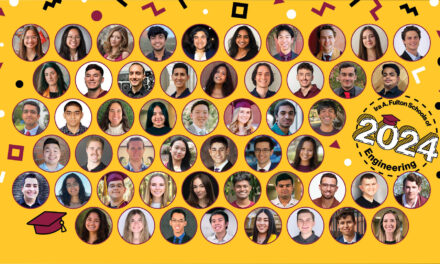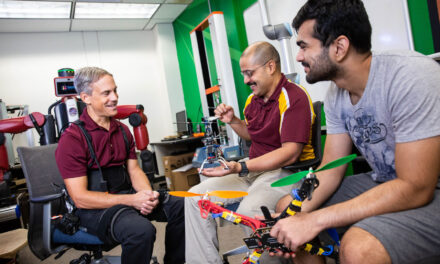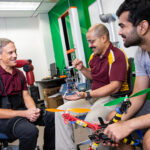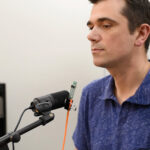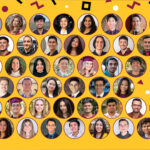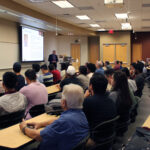
Engineering Education Systems and Design program sets game-changing goals

Above: Faculty and students in the Fulton Schools’ Engineering Education Systems and Design doctoral program hope to produce research that leads to more effective approaches to teaching engineering throughout all levels of education and across different social and cultural environments. Pictured clockwise from far left are student Eunsil Lee, Associate Professor Jennifer Bekki, Assistant Professor Micah Lande, student Ieshya Anderson, Associate Professor Shawn Jordan, students Wen Huang, Thien Ta and Mark Huerta and Assistant Professor Sohum Sohoni. Photographer: Jessica Hochreiter/ASU
Improving education takes far more than a better understanding of the subjects you’re trying to impart knowledge about. It’s equally as crucial to know a whole lot about the various people you are endeavoring to motivate and educate.
Simply put, that sums up a core challenge upon which the Ira A. Fulton Schools of Engineering at Arizona State University established its Engineering Education Systems and Design doctoral program a year ago.
That is where the simplicity ends, because the program — whose second cohort of students began studies this fall — focuses on deep explorations and analysis of “education ecosystems” in all of their multifaceted complexity.
Such ecosystems encompass the many intertwined factors that shape various individuals, groups, communities and societies, explains Associate Professor Jennifer Bekki, the chair of the program based at the Polytechnic School, one of the six Fulton Schools.
Engineering education researchers apply their understanding of the interplay of those factors in creating learning experiences and environments that will be the most effective within the context of a particular group’s social and cultural fabric.
“We try to examine all the things, including things like societal attitudes and behavioral norms, that combine to impact the educational environments in different settings,” Bekki says. “It’s much more than simply developing methods for teaching specific kinds of courses.”
“Engineering itself is based on systems thinking, and as engineering education researchers we view contexts in terms of ecosystems,” says Associate Professor Shawn Jordan.
“We may look at what motivates people, for example. We look at what connects with people in different contexts and how they can apply their engineering learnings,” says Assistant Professor Micah Lande.
“Our research in this field is kind of like applying sociology to gain a deep understanding of how people experience engineering and how they could learn it better,” he says. “People are at the center of our studies, not just the technologies that are the focus of most research in the engineering world.”
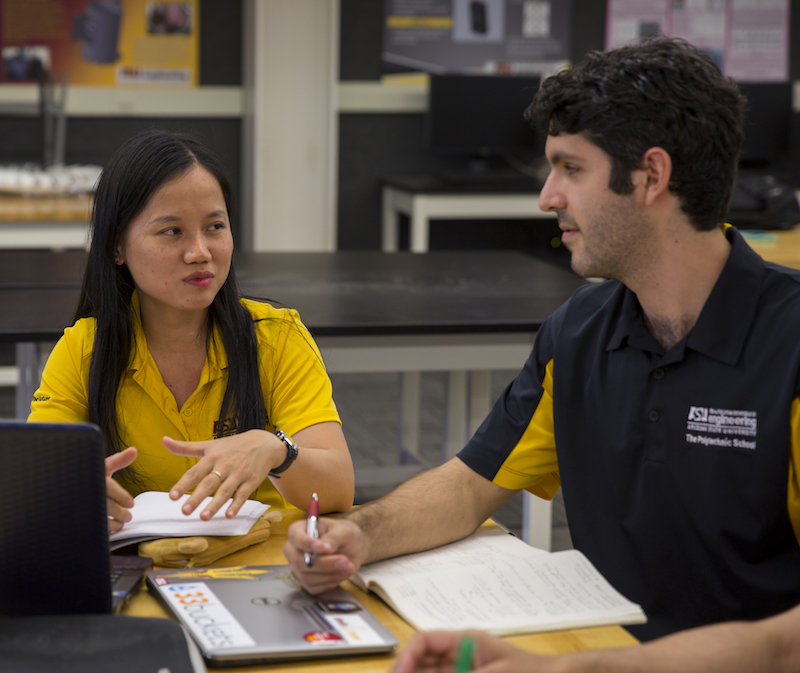
Thien Ta (left) came to Arizona State University from her home in Vietnam to earn a master’s degree in mechanical engineering and has decided to stay to pursue a doctoral degree in the Engineering Education Systems and Design program. Mark Huerta comes to the program with experience as a founder and leader of an international nonprofit venture, 33 Buckets, which works to provide access to clean water for communities in underdeveloped countries. Photographer: Jessica Hochreiter/ASU
Preparing future engineers to navigate new terrain
The aim of such research also extends to finding ways to stoke students’ interest in engineering in the first place, and then helping them persist and discover how they can make a difference and have an impact with their engineering knowledge, Lande says.
Associate Professor Adam Carberry says learning engineering is not about adopting a narrowly focused mindset — one limited only to technological know-how.
He points out that today’s professional engineers are much more likely than in decades past to work in an international industry environment where they are encountering cultural, social, ethnic and gender diversity.
“If we’re going to prepare people to be successful engineers in the future, how do we redesign educational systems to prepare them to work in that diverse terrain?” he says. “We have to get out in the world and do research to determine how to do that.”
The scope of what engineering education researchers seek to improve is far-reaching.
Better curriculum, student recruitment and retention, and more effective teaching and learning assessment strategies and analytics are only a start.
The goals extend to boosting participation of groups underrepresented in engineering professions, as well as cultivating the entrepreneurial spirit and the Maker Movement mindset among target groups that include K-12 and college students, engineering faculty members, early career professionals and members of underrepresented populations, both within and outside of formal educational settings.
Holistic approach to education design
The evolving 21st century engineering landscape demonstrates the increasing value of investing in engineering education systems and design studies and research, says Professor Ann McKenna, the director of the Polytechnic School, who helped write the proposal to form the new program and is also on the program’s faculty.
“We need more scholarship, more ideas and more people in the field who bring fresh and different points of view if the needed innovations in education are going to come to fruition,” she says.
Fulton Schools leaders are eager to see what research by the program’s faculty and students reveals that could serve their goals.
“We are continuously looking for new ways to improve student retention in all of our engineering programs,” says Professor James Collofello, Vice Dean of Academic and Student Affairs. “But we’re also anxious to watch the research findings coming out of this program be applied far beyond that.”
McKenna and Bekki re-emphasize that this undertaking does not concentrate solely on college education or even educational institutions.
“We look at the concept of an education system holistically,” Bekki says, “starting with pre-kindergarten and going up through and beyond doctoral students. And that whole educational environment along the way is impacted by families, by teachers, socioeconomic factors, school administrations and government policies.”
McKenna says researchers want to learn everything from how to encourage youngsters to view engineering as a viable career to how to design more effective extended education programs for business and industry professionals.
Jordan adds that, “Even some companies are turning to engineering educators to design, implement and assess employee training, to capture knowledge from retiring employees and to use big data analytics to make informed business decisions.”
The new doctoral program’s mission is to equip its students with knowledge and skills to work everywhere from education and research institutions, government agencies and public policy groups, to industry, science and learning centers, museums, community organizations and consulting groups.
Improving education to move society forward
Students in the program say they’re encouraged by the range of career possibilities the field may offer.
Thien Ta came to ASU from her native Vietnam to earn a master’s degree in mechanical engineering. She had planned to return soon after to a faculty position at a technical college in her homeland.
But after learning about the Engineering Education Systems and Design doctoral program, she decided to stay at ASU to earn a degree in the program.
She foresees the expertise she hopes to gain positioning her to help modernize engineering education in her country, to encourage more diversity in the engineering professions there, and elevating her own stature in the higher education profession.
Wen Huang came from China to join the program. He has degrees in areas related to software engineering and computer programming, but views the new program as a promising opportunity to gain much broader expertise in science, engineering, education and social sciences.
If he is someday able to use those skills to help drive innovation in his country and to bring a more global perspective to education there, Huang says, “it will be a very important step to improving society.”
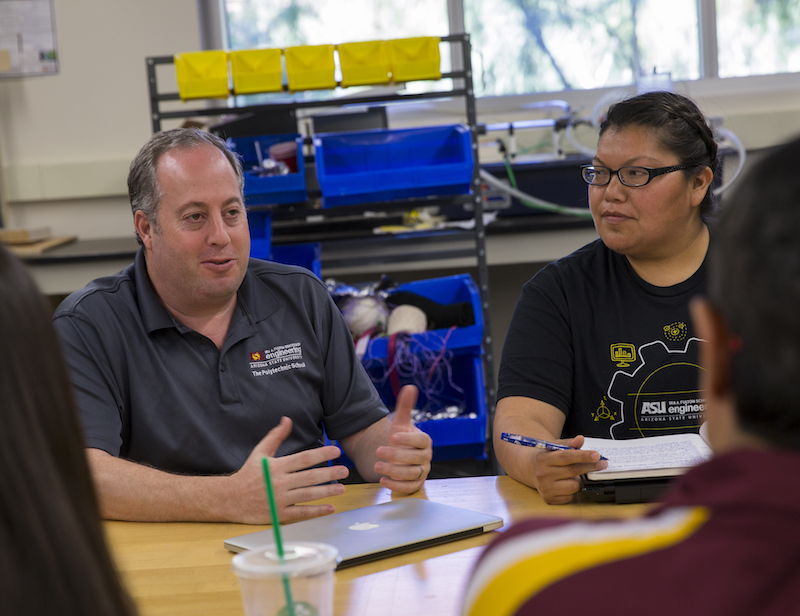
Assistant Professor Micah Lande (pictured with student Ieshya Anderson) says the still-emerging field of engineering education systems and design offers students opportunities to break new ground in education scholarship and research. Photographer: Jessica Hochreiter/ASU
Aspiring to ‘change the world for the better’
Michael Sheppard says he was attracted to the program’s “big-picture focus” on research and education.
Sheppard earned a degree in biomedical science in Virginia before serving six years in the Navy, then in 2013 earned a bachelor’s degree at the Polytechnic School in engineering with a concentration in mechanical systems. He then worked in industry for four years and most recently taught physics at a charter middle school/high school.
As his “passion for teaching” emerged, he looked for higher-level career opportunities in the field. He sees the new program helping to open paths for him in a range of pursuits, including his interests in improving educational opportunities for people “at different socioeconomic levels,” and for military veterans.
Eunsil Lee left her native South Korea to pursue a doctoral degree at a major university in the eastern United States that would advance her interests in working on the academic side of the textile engineering field she had been trained in. But after a year, she found her interest drifting away from the heavy focus on the technical aspects of teaching that particular branch of engineering.
“I wanted to stay in engineering,” she says, but decided that broadening her expertise through engineering education studies “was the right path for me.”
She found that the new Fulton Schools program appeared to be what she was looking for. After a year in the program, she says, “I’m doing the thing I want to do in my life.”
Her primary research interest is in studying engineering doctoral students from among populations in which women and international students are underserved.
By learning what experiences motivates them to pursue doctoral degrees despite social challenges they face, she hopes discover how to develop better support systems for such students.
“I am convinced that even small improvements in engineering education can have a big impact on the quality of the new engineers that we develop, and that will eventually change the world for the better,” she says.
Helping communities open up educational opportunities
Ieshya Anderson, a recent ASU graduate who earned a bachelor’s degree in the Polytechnic School’s engineering program, got an opportunity in her senior year to assist in research being done by Associate Professor Jordan for a project to promote engineering and technology education for youngsters in the Navajo Nation, which spans parts of Arizona, New Mexico and Utah.
Anderson’s father is Navajo, and she grew up mostly on the Navajo Nation in Arizona. She observed Jordan as he developed a program and curriculum designed to show those students and their communities how engineering and related fields of study could positively impact their future.
As part of the effort, Anderson also helped to manage STEAM (science, technology, engineering, arts and math) summer camps for young Navajo students.
She found Jordan’s project “really creative in the way he could design education to make it effective and meaningful” in a culture that has not traditionally had a strong connection to formal higher education in science and engineering fields.
Now a student in the new doctoral program, Anderson says she is motivated by the potential for someday using the education systems and design skills she will learn to help tribal communities elevate the educational opportunities they can offer their people.
Faculty will set example as dedicated researchers
Anderson and other students in the program will be learning those skills primarily through developing and implementing their own engineering education research projects.
“This is not about how to give a really good lecture. This is a really in-depth dive into studying all the things that affect an educational environment and finding what makes an education system thrive or fail,” says Associate Professor Nadia Kellam.
“We are training them to be really critical thinkers, equipped with the methodologies to thoroughly assess problems in ways that reveal the most productive paths to solutions,” she says.
Adds Assistant Professor Samantha Brunhaver: “Our approach is to help students learn how to design their own studies and research in a rigorous way, so that the results they get will be valid.”
The students will be aided in that laborious process by the program’s faculty members, who are involved in their own similarly demanding pursuits.
“We have a young faculty. None of us are at the stage where we are just sitting back and resting on past accomplishments,” Brunhaver says. “The students see us actively writing grant proposals, publishing papers and conducting research. In that way, we hope we can be role models for them.”
Stretching the spectrum of education design
In addition to the strong focus on “learning by doing,” Program Chair Bekki and Polytechnic School director McKenna stress that the students also have the benefit of a faculty whose research pursuits span across a broad range of disparate aspects of engineering education research.
“We’re fortunate that ASU has that openness to people who want to take things in new directions,” McKenna says. “That has helped us hire faculty who give us a critical mass of diverse expertise, with people who are leaders in their various areas of research.”
Beyond all that, adds Assistant Professor Lande, since the engineering education research field is still in its emergent stages, the program’s students have opportunities to broaden the spectrum of what the engineering education research community can contribute.
“Students have both the benefit and the burden of defining who they are and what they can do,” he says. “They are on an adventure into places where there is still new territory to discover.”






